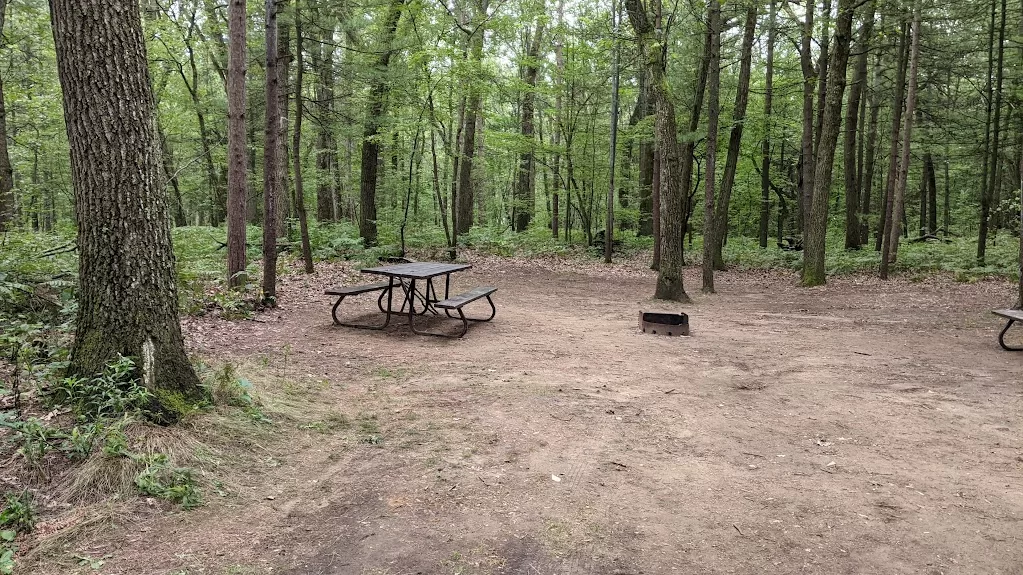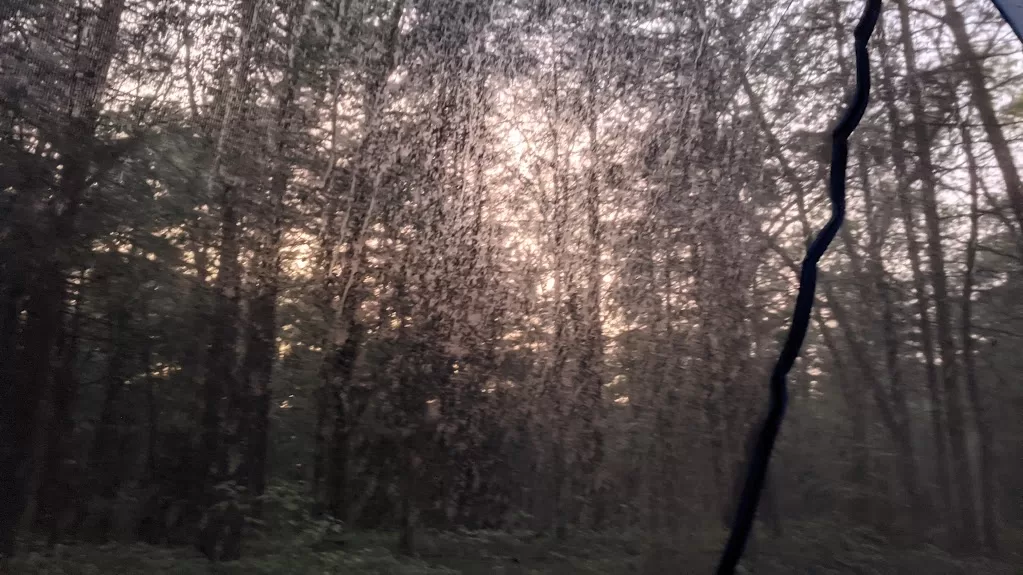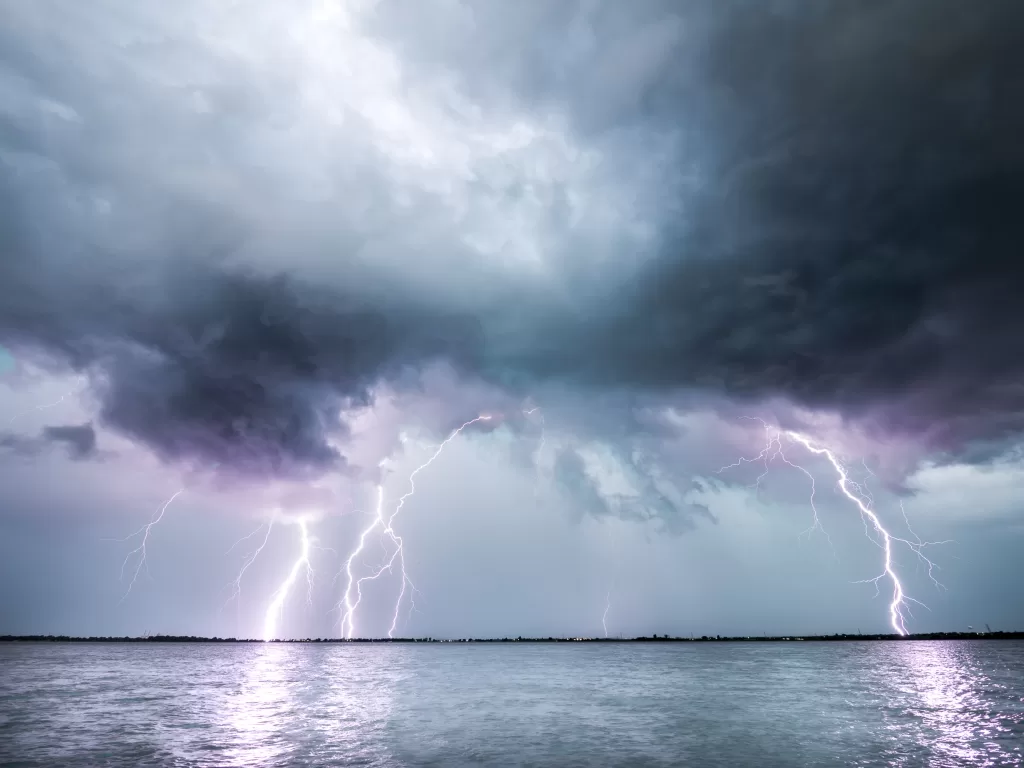The following is the transcript from our podcast episode about camping in Inclement Weather.
Pamela:
Hello, and good day, eh? Welcome to the Super Good Camping Podcast. My name is Pamela.
Tim:
And I’m Tim
Pamela:
and we are from supergoodcamping.com. We’re here because we’re on a mission to inspire other families to enjoy camping adventures such as we have with our kids. Today, we wanted to talk about inclement weather, what happens if you get caught in it, what to do about it, and how you can prepare for it. And if it is really bad, just go to a motel. And I’ll turn it over to Tim…
Tim:
So no, that’s so not camping! Motels and camping are things that don’t go together, just so we’re clear about that. You make me sad sometimes.
Setting Up Your Tent Correctly
We ran into a pretty nasty bit of weather when we were at Turkey Point last summer, in August of 2021. And man it absolutely poured rain. I don’t remember what the total rainfall was, but it was pretty crazy. It started, I want to say in the afternoon, I think it was before dinner because I remember we cooked dinner under our dining tent. We actually read for a bunch of the afternoon in our dining tent. We had a decent slope to our campsite. The people across the road from us, unfortunately, did not. Their campsite sloped to the middle of their campsite all downhill, there was no win for them.

Pamela:
And they were on the downside of our slope.
Tim:
They were on the downside of our slope, the water that ran off of our campsite ended up at the entrance to our campsite where we came in with the car. It was pretty deep. It was like a small pond. And then looking across the road beyond that pond to the campsite across the way. They were floating. I’m sure that they were on an air mattress because they would have been up at very early hours to deal with it otherwise. Nonetheless, they spent a whole bunch of their day going back and forth from the comfort station with sleeping bags that were dripping, just running with water as they went. And then they came back with sleeping bags that weren’t running with water, although they still ended up draping a bunch of them because I’m sure that they didn’t get fully dry. They I mean, they were drowned.
Pamela:
For the people that don’t know, they weren’t taking them to the washroom, they were taking them to the laundry, which is located in the comfort stations.
Tim:
Right, I’m sorry, that one hadn’t occurred to me. One of the downsides of the Ontario parks website is it doesn’t tell you that you have a hole or a dip in your site. It will give you the slope of your site. But it doesn’t tell you that there either isn’t a slope or that it’s all downhill to the middle where you’re going to put your tent. So here’s the first thing to do in inclement weather – take cover. Have cover set up, that is, your tent or dining tent or a tarp. When you set your tent up, I think we do it automatically now, we look for the higher tent pad. Somewhere with enough space, but that has a bit of a slope to it. Not a ton of slope because I don’t like having all the blood draining into my head or into my feet.
Pamela:
Or rolling downhill in the middle of the night.
Tim:
That too. That’s always fun. “Get off me” “Well, I started up there.” So the water runs away from you, hopefully.
Tarps
And then you can do other things like put a tarp over your tent. And I mean that both in a literal sense, meaning you can rig a tarp over your tent, but also there was a camping trip where we didn’t see the storm coming, it came out of nowhere, and we literally grabbed a tarp, and threw it on top of our tent when we discovered that that was the last year we were going to be using that tent (it leaked). We waterproofed it afterward and it didn’t shed the water, it just poured right in through the top of the tent. So we threw a tarp on the tent and that saved us for that day.
Pamela:
That worked well.
Tim:
It worked well, it didn’t look very pretty though, so hopefully, nobody took any pictures of that.
Waterproofing Your Tent
The newer the tent, the better. You can also do maintenance on your tents in between camping seasons. Check your seams where the stitching is. There’s a process called taping. If you buy a decent tent it has had the seams taped and the nylon itself is quite waterproof. You can buy a silicone spray. A number of companies make it. I personally have used the Woods version of it from Canadian Tire. It works well. Although that one tent that we threw the tarp on top of we couldn’t save even with two cans of Woods silicone spray. Although I had the kids do it, so maybe it was a user error. They might not have applied it properly. They probably hosed it down. You’re not supposed to. It’s supposed to have only a thin layer of silicone on it.
Rigging a Tarp Over Your Tent
So rigging a tarp over your tent. Generally, you can do it in the central line style. We’ll talk about tarp rigging at some point I’m sure but you can put a line like this as though you’re draping it over a clothesline and then pull the sides out. That’s always good. It sheds water off both sides. For tents, personally, if I’m on a slope I don’t do that style. I rig high on one side and low on the other side. High on the high side of the hill. I try to follow the contour of the land that we’re camped on so that the water gets shed downriver from you or below you and keeps running away it doesn’t get a second chance at getting under your tent which is a good segue to footprints.
Tent Footprints
Your tent has a floor in it. You can use what’s called a footprint which is kind of like a tarp that goes under your tent to protect the floor from stones, pointy sticks, that sort of deal. I’ve seen people do it before where they’ve used a tarp which is fine. You just have to make sure that the tarp is smaller or the footprint is smaller than the floor of your tent. Because if it’s bigger than the floor of your tent, it catches the water as it runs off your tent, and then it runs it under the floor of your tent anyhow. What you’re doing by using a footprint is that you’re protecting it from stones etc. You’ll be protecting it from the water that’s running by underneath your tent. Yeah, it runs under the footprint if the footprint is in place properly so it’s an extra layer of protection I suppose.
Dining Tents in Bad Weather

We also have a dining tent mentioned earlier, we took cover in that one year. They’re not always as well-designed as tents meaning they’re not as waterproof. They don’t protect you from the atmosphere as much because they often have lots of screening and they’re larger at the sides and bottom than the “roof” that’s on them for lack of a better term. So we often tarp that. Tarps are the win for inclement weather. You can’t go wrong with a tarp. We’re talking about the front country by and large.
Pamela:
There are some really nice tarps that are light.
Tim:
Yes, but they’re also stupidly expensive, but they’re great.
Tarp Rigging
There’s an English fellow, from the UK. His name is Simon, A Bloke Outdoors, is his YouTube channel. He is an amazing tarp rigger. I watched a video of his that I’ve watched twice now and just gone – wow, that’s so awesome. You can do everything with tarps. I’m a pretty basic tarp guy who puts up protection. He builds a little house to put your hammock in. He’s an amazing, amazing guy. I highly recommend going to check his channel out. String a tarp over your dining tent, it’s a wise move. Dining tents are not built to be bomb-proof. They’re not meant to be “shelter” and as much as they are somewhat, they’re not really. They keep bugs off of you though.
Trenches for Rainy Weather While Camping
Here’s another good one too. If you dig on the upriver side, or the uphill side of your tent, or your dining tent, or wherever you’re going to be, even if you’re not doing a dining tent, even if you just have a tarp and you’re going to be in a dry area. You don’t want to be splashing around in the mud. So dig a trench across the upper side of it and then dig a trench down one side or the other preferably the lower side so the water can hit the trench run through the trench and exit out south of you downhill from you. And then your little spot stays nice and dry. That’s a good one and that’s pretty easy to do even just with a tiny little camping shovel. You can drag the heel of your boot and make a trench, it doesn’t have to be awesome. Obviously the bigger the better. But dragging the heel of your boot will probably cut off 50% of the rainwater from running underneath your tarp. Otherwise, take lots of quarters to go to the comfort station and dry out your home. I felt so bad for those people!
Pamela:
Man, all of the lugging back and forth!
Tim:
and they spent so much time. It would have been a wickedly crappy night of sleep, the storm is scary
Pamela:
It was loud!
Tim:
The lightning was getting all flashy, the thunder was booming, the rain was coming down at just an incredible pace and then they woke up swimming/floating on their air mattress. I hope they were floating on their air mattresses. But then everything was soaked. Just watching them carrying so much weight over to the comfort station and then back and then another load over and back, and a sleeping bag eats up a surprising amount of space when you’re talking about washing it and drying it like a sleeping bag in a dryer. It doesn’t tumble it just fills the dryer. It will only get half dry maybe running it for a normal load and then you’re bringing it back you’re throwing it over a line and praying that it’s not still raining. So a pretty crappy deal all in all.
Checking The Weather While Camping
Pamela:
And you can’t trust the Weather Network, surprisingly.
Tim:
You know you can’t trust anything! Weirdly, I watch a few camping videos. I watched a lady today who was camping in Killarney. She checked her Garmin, which is her satellite communicator, and as part of her package, she had the option to check the weather report. Her weather report which is probably Environment Canada because she was in Killarney, said a 10% chance of rain and she was saying that while she was videoing herself huddling in a tent. It was a very similar downpour to what we had just dealt with. 10% chance of showers I think is what she said. So I don’t trust the weather report. Look up at the sky and go “Yeah, I don’t know man, that looks pretty crappy my knees kind of ache.”
Pamela:
So get ready for it. Make sure the tarp is good. And that’s it for us unless you want to talk about other inclement weather like freezing rain or hail or snow or…
Tim:
You know what they play out the same. Snow not so much because then we’re getting into talking about things like heating or having a really good sleeping bag and really good clothes. I suppose we could throw it out there, if you don’t want to be stranded inside all the time buy yourself a good rain jacket and rain pants and waterproof boots. On that note, you can spend ridiculous amounts of money on that stuff. A lot of it is about being fashionable. It’s about having a brand name on your shoulder. I tend to buy really good quality. I don’t care what it looks like, because I don’t care. I don’t care what the name on it is. I want it to be bomb-proof. So I tend to buy stuff that guys that work outdoors use. It’s usually smarter because you’re working so it’s ventable, it’s got zippers so that you don’t melt inside of it, et cetera, et cetera. Buy things that an arborist who works like a forester would wear. Do you know what I mean? Like a lumberjack-type deal. So it will wear really well. It does all the things you need it to do. It’s not pretty. Farmers, if you go to your TSC farm store, they will sell rugged stuff. It’s not Helly Hansen. It’s not a name brand, but it’s the right stuff to do what you need it to do. But I also tend to think in terms of the backcountry as opposed to the front country. Bomb-proof and ugly works for me. I don’t need to look pretty. Honestly, I have bought $800 worth of Mountain Equipment Co-Op stuff, and taken really good care of it. And it lasted me, probably 18 years. So there is something to be said about that. But it was 800 bucks. I bought $150 stuff that lasted me five years and is gone. If I do the math on this, that tends to be where I go now. That’s it. Yeah, that way at least you’re not stuck somewhere. Oh, there’s another thing for inclement weather. Take a book. Make sure you’ve got a book, man. It’s entertainment. Yeah. Or Dungeons and Dragons, whatever. Something that you can do, as opposed to sitting there with your finger buried your in left nostril.
Pamela:
Right. We have a board game called The Hobbit that you can take. Because apparently, you can’t ever win it. You just play it for hours and hours.
Tim:
Oh my God. Yes, take some rain gear so you can get outside and not be bored out of your skull. There you go.
Pamela:
And that’s it. So do as we do in scouting and be prepared. Be prepared for protecting yourself from the weather and be prepared if you get the weather. That’s it for us for today. Thank you so much for listening. I’m Pamela
Tim:
I’m Tim
Pamela:
and we are from supergoodcamping.com Please do connect with us on all of the social media and feel free to reach out to us anytime by email. Our email address is hi@supergoodcamping.com. As we’re recording this it’s Easter, so Happy Easter, happy Passover, happy Ramadan, whatever it is that you’re celebrating right now. Take care. Bye
Tim:
bye!

